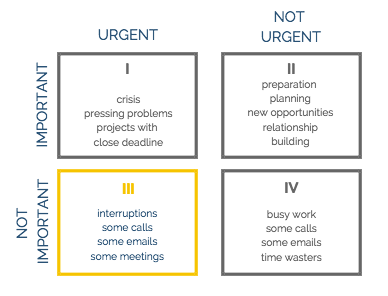Streamline Your Work: Part II
Episode #8 of the course Streamline your life to have more time for what matters by Liz Huber
Welcome back!
Yesterday, you analyzed your workload with the Eisenhower Matrix and learned how to deal with each quadrant:

Today, you’ll learn specific strategies for Quadrants III and IV. Eliminating, optimizing, automating, and delegating these unimportant tasks will free up your time for important work. Furthermore, by shifting the freed-up time to Quadrant II, you’ll be able to dramatically reduce urgency in your work life and actively prevent crises from happening (aka reducing Quadrant I work).
But before we start, I need you to promise me something:
1. You will stop doing work for work’s sake and instead, aim at achieving the maximum effect with the minimal necessary workload.
2. You will let go of the need to do everything yourself.
Got it? Then you are ready to streamline your work!
Quadrant IV
Quadrant IV is full of communication and information-related time wasters like useless meetings, emails, and social media. But since we already covered these topics in Lessons 5 and 6, we won’t go into much detail here. Instead, I want to share powerful tips on how to deal with the third type of time-wasters: busy work.

Busy work looks different in every company, but here are common examples:
• laborious (internal) presentations or reports that could easily be summarized in an email or shown on a dashboard
• organizing something for the sake of organizing it (without a clear benefit)
• certain company training programs, conferences, and coffee meetings—if they are irrelevant for your job or have no clear objective
Once you know your busy work, you can use these strategies to eliminate it:
Know that busy work has nothing to do with how it feels to do the work, but everything to do with its purpose. Thus, always question yourself: “Is this task really related to my priorities?” Check with your boss if your goals are not clearly defined!
Learn to say “NO”: Decline requests from others quickly and politely without lying or apologizing. Furthermore, giving a reason and suggesting an alternative helps avoid conflict, resentment, and burning bridges.
Challenge your boss if you don’t see the point in doing a specific task. But don’t just disagree, offer an alternative, like a different strategy or project that is more impactful or efficient.
Quadrant III
Most of the work that is urgent but not important has to do with some sort of communication, like email, meetings, and calls.

But since you already learned how to streamline your communication in Lesson 6, we won’t go into much detail here. Instead, I want to share tips on how you can save time with other Quadrant III work (basically anything that needs to get done but is not directly important for your goals):
Optimize:
• Document all recurring processes with tools like Pipefy, Manifest.ly, or Kissflow. This is the basis for optimization and efficient delegation!
• Use the process optimization principles you learned in Lesson 2: Pareto’s Law, Parkinson’s Law, batching and assigning weekly time slots, etc.
• Create templates for repeating tasks like reports and presentation.
• Be creative! Whenever you encounter a repetitive task, ask yourself, “How can this be more efficient?”
Automate. There are countless ways to automate business processes (for example, automating various workflows with Zapier). To find suitable tools, perform a simple Google search (e.g., “automate process x”) or ask people in your network who are faced with similar tasks. I won’t list more strategies here because automation is not a strategy, but a mindset: If you want to automate something, you’ll find a way!
Delegate and outsource. If you want to go all in with gaining back your time, the rule for delegation is: Delegate anything that is not directly related to your top goals and not aligned with your strengths.
Here are three ways you can make the most of delegation:
• Outsource simple tasks to virtual assistants by giving crystal-clear, step-by-step instructions or sending your process documentation.
• Delegate entire projects to your team or freelancers by giving them as much responsibility as possible (micromanagement is super inefficient), making goals and objectives clear, and scheduling regular check-ins.
• Delegate decisions by asking yourself, “What problems and requests do my employees keep coming to me for?” Then, set up “if this, then that” policies to handle similar situations in the future. For example, eliminate approval processes by setting up rules like, “Purchases under $50 don’t need to be approved.” Trust your team!
Take Action Today: Pick one recurring task, and delegate it to a team member or a virtual assistant.
Tomorrow, we’ll streamline the rest of your life!
Happy streamlining,
Liz
Recommended reading
The Right Way to Delegate and Get Awesome Results
How to Hire a Virtual Assistant
Recommended book
Optimize, Automate, and Outsource Everything In Your Life by Ari Meisel
Share with friends

